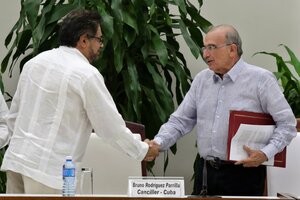Colombia's new peace deal with FARC likely to bypass opponents
After voters narrowly rejected the first peace deal with the guerrillas, President Santos is likely to send a revamped agreement to Congress for ratification. What will opponents do?

FARC lead negotiator Ivan Marquez (left) and Colombia's lead government negotiator Humberto de la Calle shake hands after signing in Havana, Cuba, a new peace deal Nov. 12, 2016, to end their 52-year war.
Enrique de la Osa/Reuters
Bogotá, Colombia
Six weeks after Colombian voters rejected a peace agreement with its main group of guerrillas, the government has announced a new deal with them.
Announcement of the deal Saturday night triggered fireworks and parties in Bogotá’s central Plaza de Simón Bolívar. Many supporters of the original deal, who thought their shot at a nation in peace had evaporated, celebrated “the end of uncertainty.” But the path forward is anything but clear.
The key question is whether the deal is ratified through Congress or goes to a second referendum, with many analysts favoring the former. President Juan Manuel Santos controls a comfortable majority in Congress.
A referendum “could polarize parties further, invite more disinformation campaigns, and generate too much uncertainty,” says Abbey Steele, a professor of political science at the University of Amsterdam and author of a forthcoming book on Colombia's civil war. “The consequences for a second loss would be enormous, maybe insurmountable.”
But bypassing a popular vote runs the risk of further alienating opponents of the original peace deal, especially since their main criticisms went unaddressed in the new accord.
The new deal "allows criminals free seats in Congress without paying the price of prison or privation of liberty,” tweeted Alfredo Rangel, a senator from the party of former President Álvaro Uribe, who led the opposition to the first peace agreement. “This is cheating."
Mr. Uribe himself – now a senator – has said little so far about the new peace deal. He told reporters on Saturday that he expects to continue to be consulted, and that the deal should not be treated as final.
Long negotiations
The new peace agreement, released in full early Monday, took 40 days of tense negotiations in Havana, Cuba. Delegations from the government and the guerrillas, known as the Revolutionary Armed Forces of Colombia or FARC, had been holed up there since October’s failed referendum. The initial deal took four years to reach, the goal to end a 52-year war that has killed 220,000 and displaced nearly 7 million.
Uribe, who led a brutal military campaign against the FARC during his presidency between 2002 and 2008, fiercely criticized the original accord. He argued that it granted impunity for rebel war criminals who wouldn’t serve a day in traditional jails, and gave them a free ride into politics with promises of guaranteed seats in Congress.
President Santos, who has staked his political reputation on the deal, sought to include Uribe and other critics for the second incarnation of a FARC agreement.
But Uribe’s main criticisms were pushed aside by Santos and his team of negotiators. The rebels who submit to the negotiated transitional justice system will still likely evade jail, instead serving reduced sentences in rural encampments. This clarifies what the original agreement described as “effective restricted liberty.”
And the rebels will still have 10 direct, unelected seats in the 268-seat Congress, lasting from 2018 until 2026. Santos defended the move, stating in a televised speech on Saturday night that “the reason for every peace process in the world is precisely that the rebels leave their weapons and are able to do politics within the law.”
The government and FARC negotiators did meet other demands from the opposition, such as the expulsion of foreign judges from the process of trying rebels in the special transitional courts. The FARC also agreed to give up all their “available” assets to fund victims’ reparations. (It’s not yet clear what assets they have and how the guerrillas’ drug money will be handled.)
A land grab?
Some continue to worry that Uribe’s enhanced power following the No vote could yet derail parts of the deal that would benefit the country’s rural, conflict-ridden communities. Many accuse Uribe and his supporters of gaining land through the conflict.
“My fear is that a key reason many in the 'No' camp actually oppose the accords is that they feel threatened by the prospect of strengthening private property protections," says Professor Steele, citing research about land ownership from Colombian economist Ana María Ibáñez. "Many people took advantage of informal property rights, fraud, and violence to expand their land holdings during the war, and do not want to see those gains reversed."
If the deal goes through Congress in the usual manner, which would mean passing some 50 laws that the agreement requires, it would mean numerous debates and legislative sessions that would be unlikely to conclude before mid-2017.
However, owing to a clause in Colombian law, it is possible that the deal can be “fast-tracked,” resulting in a simple yes/no vote from Congress.
The slow legislative route “really isn’t viable unless the FARC takes a leap of faith and starts disarming without the laws in place, which I doubt they’ll do,” says Adam Isacson, senior associate for regional security policy at the Washington Office on Latin America, a research and advocacy nonprofit in Washington.
However the deal comes to be ratified. implementing it on the ground will require nonpartisan effort, wrote Martha Ruíz, a member of the editorial council of the respected local magazine Semana, in a Monday op-ed. “Implementation can no longer be a technical matter, but above all, a broad stage of political dialogue that includes diverse sectors of civil society, such as entrepreneurs, churches, communities and independent leaders in each region.”

